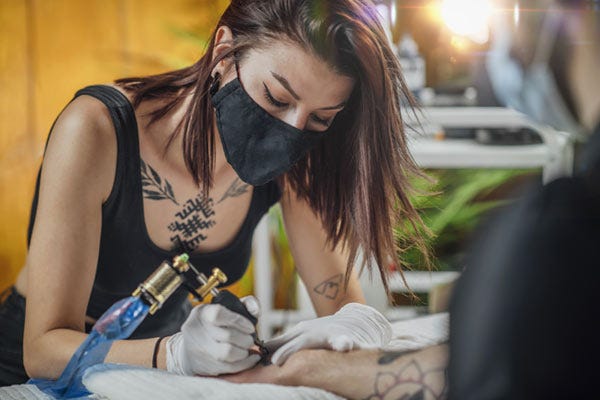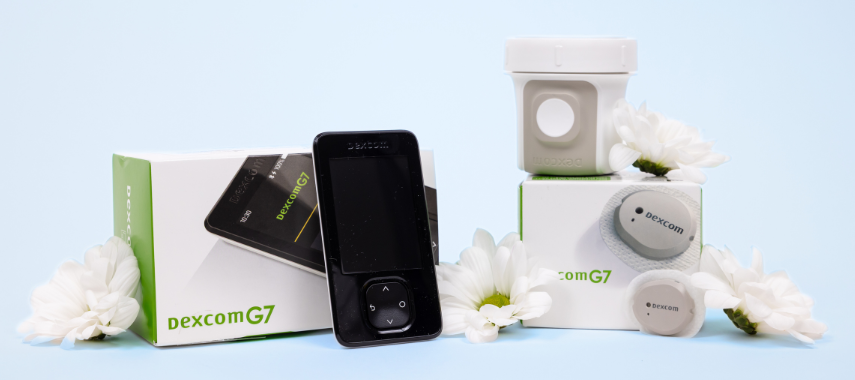Can people with diabetes get tattoos? The short answer to this question is ‘yes,’ with some caveats. Like anyone else, people with type 1 or type 2 diabetes should take safety precautions when getting body art.
The tattooing procedure utilizes a machine that pierces the skin up to 3,000 times per minute with a sterilized needle. The needle deposits pigment in the second layer of skin, called the dermis. The skin is the largest organ of the body and its purpose is to protect the body from outside contaminants. Anytime this protective barrier is damaged, there is a risk of infection.
Anyone, diabetic or no, considering getting a new tattoo should look for a reputable, licensed tattoo artist with the highest quality sanitation practices. Nonsterile needles can transmit bacterial skin infections, hepatitis, and other infectious diseases. Contaminated tattoo inks have also caused infections in some cases, according to the FDA. You can do your homework on what kind of ink will be used by your local tattoo parlor, and check the FDA website for information about any inks that have been recalled or should otherwise be avoided.
Some people may also have an allergic reaction to ingredients in the tattoo ink, resulting in a rash, blisters, or swelling at the site. This kind of reaction can happen at any time, from immediately after you get your first tattoo to decades later.
Diabetes-Related Factors to Consider
Piercing the skin poses health risks for anyone, but if you have diabetes, you are at higher risk for infection and other complications. Be sure to speak to your healthcare professional so they can evaluate your risk before you proceed.
If you get the all-clear, it’s important to know how your diabetes will impact your experience. Below we’ve included some special considerations for diabetics interested in getting a new tattoo.
Blood Sugar Levels
The primary reason that diabetics are sometimes told they shouldn’t get a tattoo has to do with their blood glucose levels. According to the American Diabetes Association, people with type 1 diabetes and others with chronically high blood sugar levels have reduced ability to fend off bacterial infections. This is why people with diabetic neuropathy have to pay special attention to the skin on their feet where numbness may make it difficult to feel blisters and abrasions. Even small wounds like these can be become dangerously infected if not treated soon enough, sometimes leading to amputation.
You will want to have stable, healthy blood glucose or A1C test results for at least three to four months prior to getting a tattoo. Your doctor may recommend that you wait if your test results are not in target range.
It’s also important to know that the tattooing procedure itself can be quite taxing on the body, especially for larger and more complex tattoos that require several hours. It can sometimes cause blood sugar levels to go up temporarily to fuel your body’s natural immune response to stress, and then drop. It’s critical that you have stable blood glucose levels going in and take snack breaks when needed to avoid low blood sugar.
Healing Process
People with consistently high blood sugar levels are also at higher risk for slow wound healing due to increased inflammation and poor immune response. The longer your tattoo takes to heal, the greater the chance for a dangerous infection to develop, which in turn is more difficult to fight off.
Speak with your tattoo artist about what the typical healing time is, and what the healing process looks like at each stage. For example, how long should swelling, redness and scabbing last? If you notice any adverse reactions, consult with your doctor right away.


Tattoo Placement
It’s best for people with diabetes to avoid getting tattoos in areas of the body with poor blood circulation, which can further complicate the wound healing process. These include feet, ankles, shins, hands, and buttocks.
It’s also a good idea to avoid common insulin injection sites or areas where you will apply a wearable insulin pump or continuous glucose monitor (cgm). After all, the more you disturb the tattoo site with additional injections and skin pricks, the longer it will take to heal and the more the appearance and clarity will diminish.
Medical Alert Tattoos
Some people with diabetes are opting for a so called ‘diabetes tattoo’ in lieu of a traditional medical ID bracelet. A quick search on the Internet reveals a multitude of diabetes tattoo design ideas to inspire the imagination. Often they read ‘Type 1 Diabetic’ or ‘Insulin Dependent’ so that first responders will be aware should there be a medical emergency.
However, designs vary widely and it’s not always clear that they will work as intended. Paramedics may not see them right away depending on the placement, or they may be hard to read. Also, some people get a diabetes awareness tattoo to indicate their support for a friend or family member who has the condition, not necessarily themselves. Speak with your diabetes care professional about the safety of using a tattoo to serve as your medical ID, and if you should wear a bracelet or carry an ID card as a backup.
Aftercare
Getting a tattoo should not be viewed as an endeavor that begins and ends with the procedure itself, but rather a long-term process that requires commitment. Because people with diabetes are at an increased risk of complications resulting from piercing the skin, it’s crucial to follow the recommended aftercare plan to the letter so that your skin has the best chance for a speedy recovery. Your tattooist should be informed of your condition prior to the procedure so they can tailor a regimen to fit your needs. Your doctor may have additional recommendations as well.
References
Cosmetic Recalls & Alerts, US Food & Drug Administration
Think Before You Ink: Are Tattoos Safe?, US Food & Drug Administration
Tattoos & Permanent Makeup Fact Sheet, US Food & Drug Administration
Tattoos: 7 Unexpected Skin Reactions and What To Do About Them, American Academy of Dermatology Association
Risk of Infection in Type 1 and Type 2 Diabetes Compared With the General Population: A Matched Cohort Study, Diabetes Care Journal, 2018
Diabetes and Skin Complications, American Diabetes Association
Information provided on the Aeroflow Diabetes blog is not intended as a substitute to medical advice or care. Aeroflow Diabetes recommends consulting a doctor if you are experiencing medical issues or concerns.






